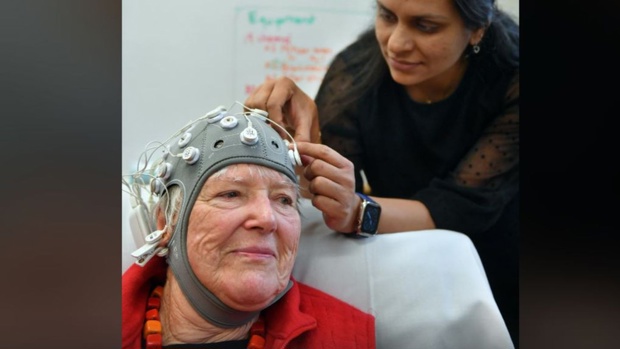Scientists’ ‘accidental miracle’ restores Dunedin woman’s eyesight
- Publish Date
- Friday, 19 May 2023, 9:49AM

Dr Divya Adhia attaches cables to a cap covered with electrodes, which unexpectedly helped to restore Dunedin author Dr Lynley Hood’s vision recently. Photo / Stephem Jaquiery
Scientists are calling it “an accidental miracle” after research aimed at alleviating chronic pain was found to restore the sight of a Dunedin woman who has had an acute form of glaucoma for more than a decade.
Now University of Otago researchers are trying to replicate the result, in a bid to create new treatments for people with vision loss.
Prominent author Dr Lynley Hood (80) fractured her pelvis in a fall in 2020 and has had severe lower back pain ever since.
So she decided to participate in a University of Otago chronic pain treatment research project involving the placement of a cap on her head, wired with electrodes that use electrical currents to stimulate the brain.
Project co-leader Dr Divya Adhia said the Dunedin School of Medicine research began in May 2021 and looked at the effects of brain stimulation on chronic pain.
Dr Hood attended brain stimulation sessions five days a week for a month, she said.
There were two study groups — the main group, which received the electrical stimulation into the brain, and the placebo group, which had the electrical current pass across their scalps.
Dr Hood was part of the placebo group, and over the four-week period her eyesight steadily improved to nearly 100 per cent, Dr Adhia said.
“Surprisingly, her vision improved so much that her ophthalmologist said it was a miracle.
“Miracle is not a word we use very often in science, but it was — an accidental miracle.
“It wasn’t the intended outcome, but to see that my research has actually made an impact with people is really miraculous.”
Dr Hood said she had been living with severely reduced vision for the past 12 years.
She had no central vision in her left eye, her right eye was like “TV static” and it was difficult for her to adapt to changing light conditions.
It had effectively stopped her from reading and writing and she had to give up her work as an award-winning author.
She was told her eyesight was never going to get any better, so she took it in her stride and decided to help others with low vision by becoming a founding member of the Visual Impairment Charitable Trust Aotearoa (Victa).
To have her vision slowly return following the procedures was life-changing, she said.
“At first, I thought I was imagining it.
“They’ve got such flash equipment that they could trace every millisecond of the current — it went across my scalp and into my eyes.
“The equipment showed that the cells in my retina went, ‘Hey guys, something’s happening’, and it sent a whole lot of messages down my optic nerve to the parts of my brain that makes pictures and words and colours out of electrical messages.
“It’s really important that other people benefit from this.”
Dr Adhia said the research team were now designing another study to run alongside the chronic pain study, which would investigate how it had happened and how it could be used to improve low vision for other people.
Dr Hood was also excited. She said the “side effect” had given her a new lease on life and she now had plans to return to writing and had several new books in the pipeline.
How incredible!
This article was first published in the NZ Herald by John Lewis and is republished here with permission.

Take your Radio, Podcasts and Music with you

